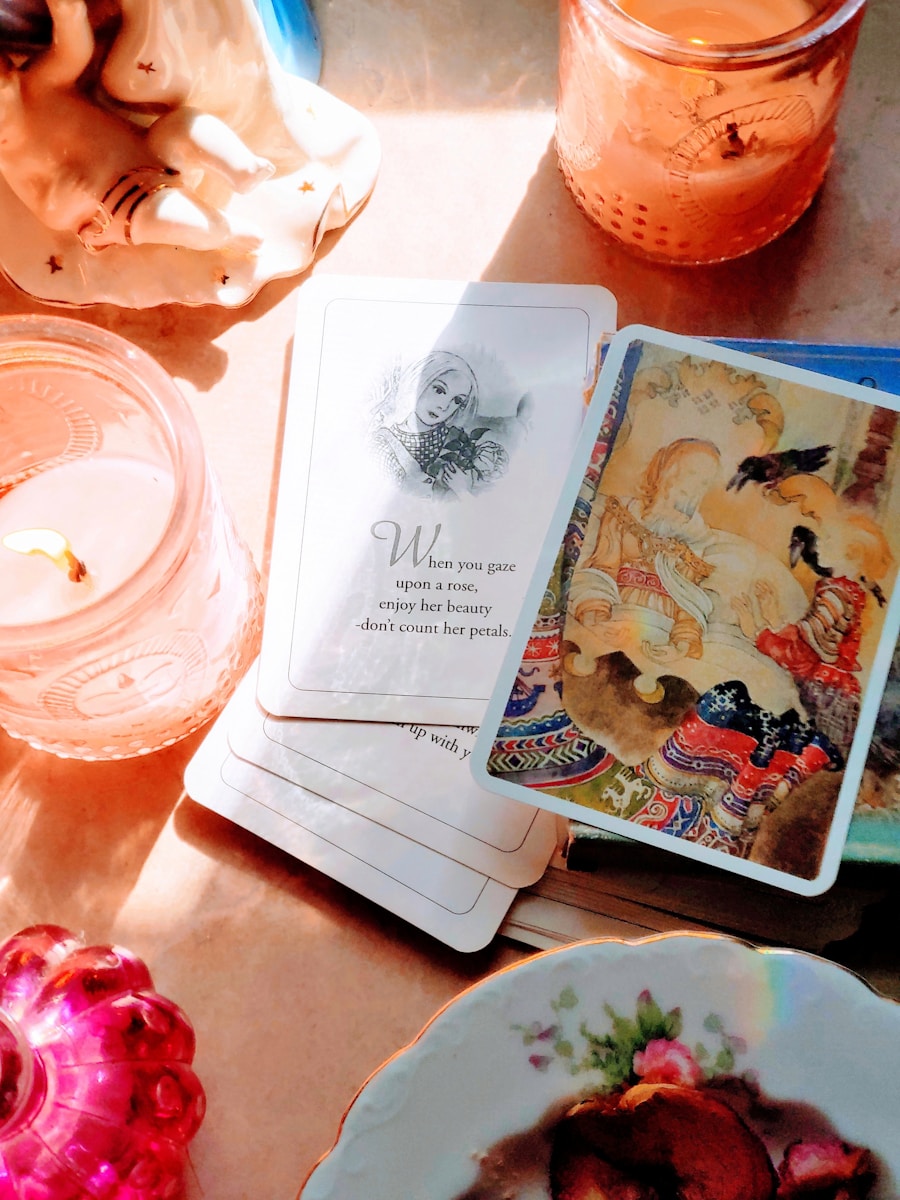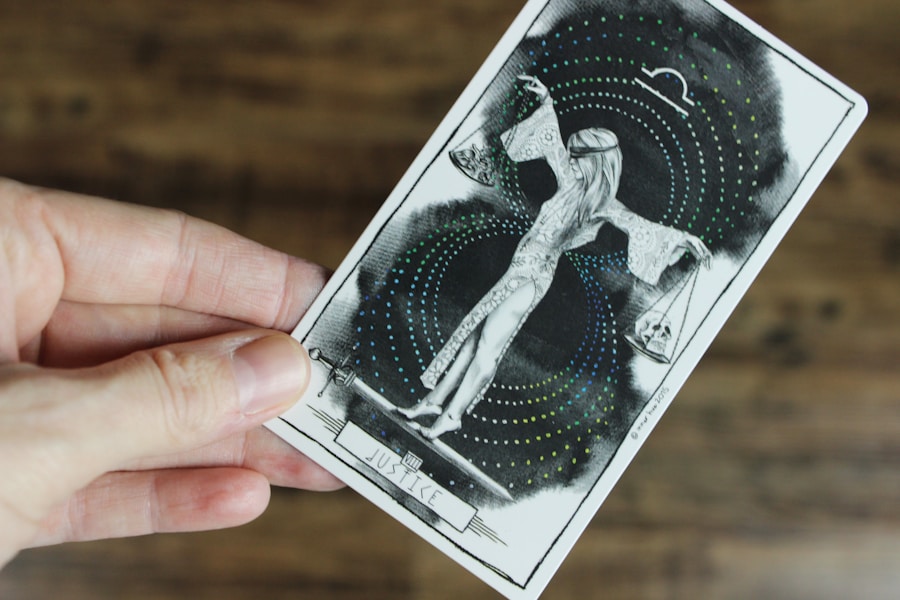To embark on your journey into the world of Tarot, it is essential to grasp the fundamental concepts that underpin this ancient practice. At its core, Tarot consists of a deck of 78 cards, divided into two main sections: the Major Arcana and the Minor Arcana. The Major Arcana comprises 22 cards that represent significant life events, spiritual lessons, and deep psychological archetypes.
Each card in this section carries profound meanings and is often seen as a reflection of the human experience. The Minor Arcana, on the other hand, consists of 56 cards divided into four suits: Cups, Pentacles, Swords, and Wands. These cards typically address everyday situations and challenges, providing insight into the more mundane aspects of life.
As you delve deeper into Tarot, you will discover that each card is rich with symbolism and layered meanings. The imagery on the cards serves as a visual language that communicates complex ideas and emotions. Understanding the basics of Tarot involves not only familiarising yourself with the cards but also recognising how they interact with one another during a reading.
Each card can take on different meanings depending on its position in a spread and the context of the question posed. This dynamic nature of Tarot makes it a versatile tool for self-reflection and guidance.
Summary
- Tarot is a tool for self-reflection and insight, not fortune-telling
- Connecting with the cards involves meditation and personal interpretation
- Developing intuition is key to understanding the deeper meanings of the cards
- Symbolism and imagery in tarot cards can have personal significance
- Creating personal associations with the cards can enhance your readings
- Regular practice and reflection are essential for improving tarot reading skills
- Seeking guidance from experienced readers can provide valuable insights and advice
- Trusting your own interpretations is crucial in tarot reading
Connecting with the Cards
Building a connection with your Tarot deck is a crucial step in your journey. This relationship is not merely about memorising card meanings; it is about developing a personal bond with the cards that allows you to tap into their energy and wisdom. One effective way to establish this connection is by spending time with your deck.
You might consider holding each card in your hands, observing its imagery, and reflecting on what emotions or thoughts arise. This tactile experience can help you feel more attuned to the cards and their messages. Another method to deepen your connection is to create a sacred space for your Tarot practice.
This could be a quiet corner in your home where you feel comfortable and undisturbed. You might choose to light a candle or burn incense to set the mood, allowing yourself to enter a more meditative state. As you shuffle the cards, focus on your breath and clear your mind of distractions.
This intentional practice not only enhances your connection with the cards but also prepares you for more insightful readings.
Developing Your Intuition

Intuition plays a vital role in Tarot reading, as it allows you to interpret the cards beyond their traditional meanings. Developing your intuition is an ongoing process that requires patience and practice. One way to nurture this skill is through regular meditation.
By quieting your mind and tuning into your inner self, you create space for intuitive insights to emerge.
Another effective technique for honing your intuition is to engage in daily card pulls.
Each morning, draw a single card from your deck and take time to reflect on its significance for the day ahead. Rather than relying solely on established interpretations, allow your intuition to guide you in understanding what the card means for you personally. Over time, this practice will strengthen your ability to trust your instincts during readings, enabling you to provide more nuanced insights.
Exploring Symbolism and Imagery
The rich symbolism found within Tarot cards is one of the most captivating aspects of this practice. Each card is adorned with intricate imagery that conveys multiple layers of meaning. As you explore these symbols, consider how they resonate with your own experiences and beliefs.
For instance, the imagery of the Moon may evoke feelings of intuition and mystery, while the Sun might represent joy and clarity. By examining these symbols closely, you can uncover deeper insights that may not be immediately apparent. To enhance your understanding of Tarot symbolism, consider keeping a journal dedicated to your reflections on each card.
As you study the imagery, jot down your thoughts and feelings about what each symbol represents to you personally. This exercise not only deepens your comprehension of the cards but also allows you to create a personalised reference guide that reflects your unique interpretations. Over time, you will find that your understanding of symbolism evolves, enriching your readings with newfound depth.
Creating Personal Associations
While traditional interpretations of Tarot cards provide a solid foundation for understanding their meanings, creating personal associations can elevate your readings to new heights. Each individual brings their own experiences, beliefs, and emotions to their Tarot practice, making it essential to incorporate these elements into your interpretations. As you work with your deck, take note of any personal connections or memories that arise when you encounter specific cards.
For example, if you draw the Lovers card and associate it with a significant relationship in your life, this personal connection can inform your reading in profound ways. By acknowledging these associations, you allow yourself to tap into a deeper well of insight that resonates with your unique journey. This practice not only enriches your readings but also fosters a sense of empowerment as you learn to trust your own interpretations.
Practicing and Reflecting

Like any skill, mastering Tarot requires consistent practice and reflection. Set aside regular time for readings, whether for yourself or others, to hone your abilities and deepen your understanding of the cards. As you engage in this practice, consider experimenting with different spreads and techniques to discover what resonates most with you.
Whether you prefer simple three-card spreads or more complex layouts, each reading offers an opportunity for growth. After each reading, take time to reflect on the insights gained and how they relate to your life or the lives of those you read for. Journaling about your experiences can be particularly beneficial; it allows you to track patterns over time and identify areas where your intuition has guided you accurately or where further exploration may be needed.
This reflective process not only reinforces your learning but also cultivates a sense of confidence in your abilities as a reader.
Seeking Guidance from Experienced Readers
As you navigate your Tarot journey, seeking guidance from experienced readers can provide invaluable insights and support. Connecting with others who share your passion for Tarot can open doors to new perspectives and techniques that enhance your practice. Consider joining local or online Tarot communities where you can engage in discussions, share experiences, and ask questions.
Attending workshops or classes led by seasoned Tarot practitioners can also be immensely beneficial. These opportunities allow you to learn from their expertise while gaining practical experience through hands-on exercises. Additionally, observing how others interpret the cards can inspire new ways of thinking about their meanings and applications in readings.
Trusting Your Own Interpretations
Ultimately, one of the most empowering aspects of Tarot is learning to trust your own interpretations. While guidance from experienced readers and established meanings can be helpful, it is essential to remember that you are the best authority on your own experiences and insights. As you continue to develop your skills and deepen your connection with the cards, allow yourself the freedom to explore interpretations that resonate with you personally.
Embrace the idea that there are no right or wrong answers in Tarot; each reading is an opportunity for exploration and self-discovery. By trusting yourself and honouring your unique perspective, you will find that your readings become more authentic and meaningful over time. This journey is not just about predicting the future; it is about understanding yourself better and navigating life’s complexities with clarity and confidence.
In conclusion, delving into the world of Tarot offers a rich tapestry of exploration and self-discovery. By understanding the basics, connecting with the cards, developing intuition, exploring symbolism, creating personal associations, practising regularly, seeking guidance from others, and ultimately trusting yourself, you will cultivate a profound relationship with this ancient art form. Embrace the journey ahead with an open heart and mind; each card drawn holds the potential for insight and transformation in your life.
FAQs
What is Tarot?
Tarot is a form of divination that uses a deck of cards to gain insight into past, present, and future events, as well as to explore spiritual and psychological aspects of the self.
What is a Tarot guidebook?
A Tarot guidebook is a book that accompanies a Tarot deck and provides interpretations and meanings for each card, as well as instructions on how to use the cards for readings.
How can I read Tarot without a guidebook?
You can read Tarot without a guidebook by developing your own interpretations of the cards through intuition, personal reflection, and practice.
How can I develop my own interpretations of Tarot cards?
To develop your own interpretations of Tarot cards, you can start by studying the imagery, symbolism, and traditional meanings of the cards, and then reflect on how these elements resonate with your own experiences and intuition.
What are some tips for reading Tarot without a guidebook?
Some tips for reading Tarot without a guidebook include keeping a Tarot journal to record your interpretations and insights, meditating with the cards to deepen your connection with them, and seeking guidance from experienced Tarot readers or mentors.
Is it important to memorise the traditional meanings of Tarot cards?
While it can be helpful to have a basic understanding of the traditional meanings of Tarot cards, it is not essential for reading Tarot without a guidebook. Developing your own interpretations based on personal intuition and reflection is equally valid.
Can anyone learn to read Tarot without a guidebook?
Yes, anyone can learn to read Tarot without a guidebook with dedication, practice, and an open mind. It is a personal and intuitive process that can be developed over time.




















